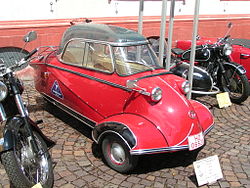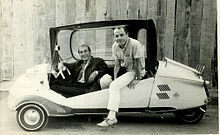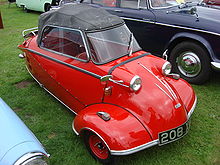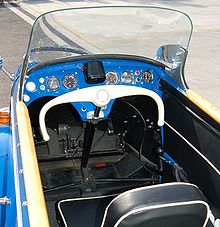- Messerschmitt KR200
-
Messerschmitt KR200 
Manufacturer Regensburger Stahl- u. Maschinenbau, Regensburg, Germany Also called Kabinenroller, Karo Production 1956-1964
approximately 40,000Predecessor Messerschmitt KR175 Successor None Class Microcar Body style bubble-top coupé, convertible, or roadster; two seats in tandem. Layout RMR layout Platform Messerschmitt Kabinenroller Engine Fichtel & Sachs two-stroke single cylinder, operable in both directions of crankshaft rotation Transmission Four speeds forward or reverse (depending on engine rotation), sequential, unsynchronized. Wheelbase 79.9 in (202.9 cm) [1] Length 111.0 in (281.9 cm) [1] Width 48.0 in (121.9 cm)[1] Height 47.2 in (119.9 cm)[1] Curb weight 506 lb (229.5 kg) (curb)[1] Related Messerschmitt KR175
Messerschmitt KR201 (roadster)
FMR Tg500Designer Fritz Fend The Messerschmitt KR200, or Kabinenroller (Cabin Scooter), was a three-wheeled bubble car designed by the aircraft engineer Fritz Fend and produced in the factory of the German aircraft manufacturer Messerschmitt from 1955 to 1964.
Contents
History
Messerschmitt, temporarily not allowed to manufacture aircraft, had turned its resources to producing other commodities. In 1952, Fend approached Messerschmitt with the idea of manufacturing small motor vehicles.[2] These were based on his Fend Flitzer invalid carriage.[3]
The first of Fend's vehicles to enter production at Messerschmitt's Regensburg factory was the KR175.[4] The title Kabinenroller means "scooter with cabin".[5] While the Messerschmitt name and insignia were used on the car, a separate company, incorporated as Regensburger Stahl- und Metallbau GmbH, was created to manufacture and market the vehicle.[4]
The KR200 replaced the KR175 in 1955.[4] While using the same basic frame as the KR175 with changes to the bodywork (notably including wheel cutouts in the front fenders) and an improved canopy design,[6] the KR200 was otherwise an almost total redesign.[7] The rear suspension and engine mounting were reworked, and hydraulic shock absorbers were installed at all three wheels. Tire sizes were enlarged to 4.00x8.[6]
Retailing for around DM 2,500, the KR200 was considered an instant success with almost 12,000 built during its first year.[8] A maximum speed in excess of 90 km/h (56 mph)[8] despite a claimed power output of only 10 PS (7.4 kW; 9.9 hp)[8] reflected the vehicle's light weight.
In 1956, Messerschmitt was allowed to manufacture aircraft again and lost interest in Fend's microcars. Messerschmitt sold the Regenburg works to Fend, who formed Fahrzeug- und Maschinenbau GmbH, Regensburg (FMR) to continue production of the KR200 and his other vehicles.[9]
In 1957, the KR200 Kabrio model was released, featuring a cloth convertible top and fixed side window frames. This was followed by the KR201 Roadster without window frames, using a folding cloth top, a windscreen, and removable side curtains. A Sport Roadster was later offered with no top and with the canopy fixed into place so that the driver would have to climb in and out at the top of the car.[9]
Production of the KR200 was heavily reduced in 1962 and ceased in 1964[10] as sales had been dropping for a few years. The demand for basic economy transport in Germany had diminished as the German economy boomed.[11] A similar situation developed in other parts of Europe such as in the manufacturer's biggest export destination, the United Kingdom, where sales were particularly affected by the increasing popularity of the Mini.
24-hour record run
In 1955, in order to prove the KR200's durability, Messerschmitt prepared a KR200 to break the 24-hour speed record for three-wheeled vehicles under 250 cc (15.3 cu in). The record car had a special single-seat low-drag body and a highly modified engine, but the suspension, steering, and braking components were stock. Throttle, brake, and clutch cables were duplicated. The record car was run at the Hockenheimring for 24 hours and broke 22 international speed records in its class, including the 24-hour speed record, which it set at 103 km/h (64 mph)[6][12]
Messerschmitt Service Car
Messerschmitt, and subsequently FMR, made factory-converted Service Cars to order for the automobile service industry. Similar in concept to the Harley-Davidson Servi-Car and the Indian Dispatch Tow, the Service Car had a detachable tow bar and clamp, a revised front suspension to accommodate the tow bar when in use, and a storage system inside the car to accommodate the tow bar when not in use. The service technician would drive the Service Car to the customer's car and, if the customer's car was drivable, attach the tow bar to the front of the Service Car, clamp the other end of the tow bar to the bumper of the customer's car, and drive the customer's car to the garage. When the service was complete, he would drive the car back to the customer while towing the Service Car, detach the Service Car from the customer's car, and drive back to the garage. Approximately 12 were built; only one is known to exist at present.[13]
Features
The KR200 incorporated several features unique to the KR line and its four-wheeled derivative, the FMR Tg500. Externally, the narrow body, the transparent acrylic bubble canopy and low stance were among the more obvious features.
Tandem seating
The narrow body, and corresponding low frontal area, was achieved with tandem seating, which also allowed the body to taper like an aircraft fuselage, within a practical length. 10 PS (7.4 kW; 9.9 hp) propelled the KR200 to around 105 km/h (65 mph). The consumption of the car was 87 mpg-imp (3.2 L/100 km).
The tandem seating also centralized the mass of the car along the longitudinal axis which, combined with the low center of gravity, low weight, and wheel placement at the vehicle's extremes, gave the KR200 good handling characteristics[14] A more minor advantage of tandem seating was that it made an export version to countries that drive on the left unnecessary. An "Export" model was built, but this denoted a more luxurious trim level.[6]
Bubble canopy
Entry to most KR models except the KR201 Sport Roadster and a corresponding Tg500 version was through a canopy door hinged on the right side of the vehicle. The door included all the windows (windshield, window frames on all but the Roadster models, folding top on Roadster and Kabrio models, and acrylic bubble on other versions) and the frame in which it was set, extending from the right side of the monocoque tub to the left. On Sport Roadster models, the canopy was fixed and there was neither a top nor any windows at all, only a tonneau cover.[9]
The bubble top on the KR200 was simplified over that of the KR175 by the use of a larger curved glass windshield that formed A-pillars with the side window frames. This allowed the bubble to be simpler and more compact than the KR175 bubble, and it was consequently easier and less expensive to produce. The windshield wiper, manual on the KR175, was electric on the KR200.[6]
Engine and transmission
The KR200 ran on a 191 cc (11.7 cu in) Fichtel & Sachs air-cooled single cylinder two-stroke engine positioned in front of the rear wheel,[6] just behind the passenger's seat.[3] The engine had two sets of contact breaker points and, to reverse, the engine was stopped and then restarted, going backwards. This was effected by pushing the key further in the ignition switch than normal, whether intentionally or not. One result of this was that the KR200's sequential, positive-stop transmission provided the car with the same four gear ratios available in reverse as in forward movement.[6]
Controls
Apart from the dual-mode ignition, the KR200 had a steering bar reminiscent of that of an aircraft. Operated by pushing rather than by turning, the steering bar was connected directly to the track rods of the front wheels, providing an extremely direct response best suited to small, measured inputs.[4][14] The gearshift lever had a secondary lever on it which, when actuated, would put the car in neutral regardless of what gear it had been in before, although the transmission would have to be shifted back to first before the car would be able to move from a standstill.
Unlike the KR175, the KR200 had a full set of pedals: clutch, brake, and accelerator. The brake pedal still operated mechanical brakes using cables.[6]
Legacy
There are car clubs in Europe, the US, and elsewhere that still value these cars, usually for their quirky character rather than their actual monetary value. Nonetheless, some collectors will pay over 20,000 euros for a well-maintained "Schmitt".
Aftermarket reproduction parts are made for the KR200, including reproduction bubble tops made from car-safe polymethyl methacrylate.
Trivia
Granada Television's Fred Talbot is seen driving a Messerschmitt KR200 on the Granada Reports feature Where's Fred? in which the viewer has to identify which North West England location the presenter is in that week.
See also
- Bubble car
- Canopy door
- Corbin Sparrow
- Heinkel Kabine
- Isetta
- List of microcars by country of origin
- Microcar
- Velorex
References
Notes
- ^ a b c d e "Under the Bubble" p.177
- ^ "Ist das nicht ein Kabinenroller?" p.163
- ^ a b "Ist das nicht ein Kabinenroller?" p.164-165
- ^ a b c d "Ist das nicht ein Kabinenroller?" p.167
- ^ "Ist das nicht ein Kabinenroller?" p.162
- ^ a b c d e f g h "Ist das nicht ein Kabinenroller?" p.168
- ^ Bruce Weiner Microcar Museum: 1955 Messerschmitt KR200
- ^ a b c "Erinnern Sie sich? Messerschmitt KR 200: Menschen in Aspik", pp. 74 - 76
- ^ a b c "Ist das nicht ein Kabinenroller?" p.169
- ^ Cawthon, B. "Fritz Fend's Marvelous Micro-cars"
- ^ Bruce Weiner Microcar Museum: 1964 Messerschmitt KR200 Roadster
- ^ Canadian Driver: Messerschmitt, 1953-1962
- ^ Bruce Weiner Microcar Museum: 1961 Messerschmitt Service Car
- ^ a b "Cleared for take-off", p.46
Bibliography
- Wagner, Carl (Second Quarter 1973). ""Ist das nicht ein Kabinenroller?" "Ja! das ist ein Kabinenroller!" Carl Wagner takes off on Messerschmitt" (in US English). Automobile Quarterly (40 East 49th Street, New York, NY 10017 USA: Automobile Quarterly) 11 (2): 162–171. Library of Congress Catalog Card Number 62-4005.
- Wagner, Carl (Second Quarter 1973). "Under the Bubble: A Short Flight in a Messerschmitt KR200" (in US English). Automobile Quarterly (40 East 49th Street, New York, NY 10017 USA: Automobile Quarterly) 11 (2): 172–177. Library of Congress Catalog Card Number 62-4005.
- "Cleared for take-off" (in UK English). Thoroughbred & Classic Cars (King's Reach Tower, Stamford Street, London SE19LS, UK: IPC Magazines) 23 (5): 42–46. February 1996.
- "Erinnern Sie sich? Messerschmitt KR 200: Menschen in Aspik". Auto Motor u. Sport Heft 7 1976: Seite 74–76. date 27 March 1976.
- "Bruce Weiner Microcar Museum: 1955 Messerschmitt KR200". http://microcarmuseum.com/tour/messerschmitt-kr200-1955-9.html. Retrieved 22 August 2008.
- "Bruce Weiner Microcar Museum: 1961 Messerschmitt Service Car". http://microcarmuseum.com/tour/messerschmitt-servicecar.html. Retrieved 7 August 2009.
- "Bruce Weiner Microcar Museum: 1964 Messerschmitt KR200 Roadster". http://microcarmuseum.com/tour/messerschmitt-kr200-roadst.html. Retrieved 22 August 2008.
- Cawthon, Bill (2008-03-01). "Fritz Fend's Marvelous Micro-cars". http://www.promotex.ca/index.php. Cadabra. http://www.promotex.ca/articles/cawthon/2004/2004-03-01_article.html. Retrieved 23 August 2008.
- Vance, Bill (2003-04-19). "Canadian Driver: Messerschmitt, 1953-1962". http://www.canadiandriver.com/index.htm. CanadianDriver Communications. http://www.canadiandriver.com/articles/bv/messerschmitt.htm. Retrieved 30 August 2008.
External links
Categories:- Microcars
- Rear mid-engine, rear-wheel drive vehicles
- Three-wheeled motor vehicles
Wikimedia Foundation. 2010.



